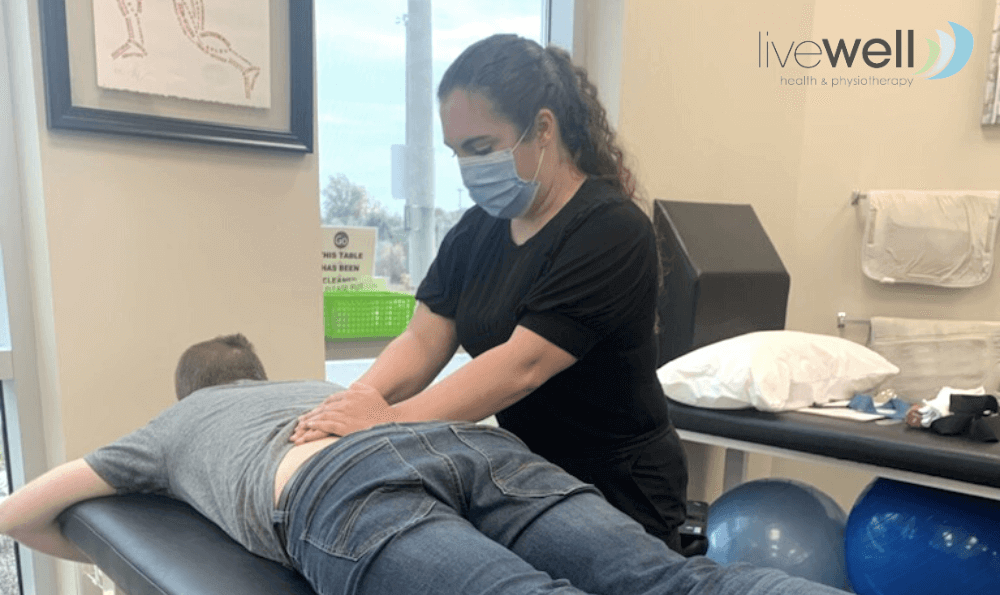Although very common among adults, chronic back pain is often played off as normal or something you should just live with. However, that is not the case! You can do several things to pinpoint and treat your back pain. So, if you’re suffering from chronic back pain and want to get back to living a pain-free lifestyle, follow this month’s blog to learn how you can treat your chronic back pain!
1) Physical Therapy
Exercise with physical therapy is often the first line of defence against back pain. Our team of physiotherapists can provide you with specific exercises to help decrease symptoms, reduce pain, strengthen your core muscles, improve back function, and increase spine flexibility. Put simply, if you can increase your strength, flexibility, and endurance, then your back pain will decrease. One of the main goals is to strengthen the core muscles that support your back because a weak core will distribute weight unequally throughout your spine and legs, resulting in back pain.
Alleviating chronic back pain starts by understanding how to keep your spine properly aligned so that you are not putting extra strain on your back. Our chiropractors can teach you how to sit, stand, sleep, and move to prevent further pain. With time and consistency, our physiotherapists can help create a personalized treatment plan to restore your ability to perform daily tasks with minimum pain and discomfort.

2) Mindfulness and Meditation
Chronic back pain not only strains you physically, but also emotionally. It is important to manage the mental toll of back pain when it comes to handling frustration, anger, sadness, stress, or any other negative feelings. While it is common and normal to feel these emotions while dealing with chronic pain, they can actually increase the pain you’re experiencing.
Mindful exercises can help you focus your body on the present moment and distract your mind from worrying or focusing on the pain. However, without help, this is easier said than done. Our team of specialists may recommend different types of regular mindfulness practices or relaxation techniques. These can include practicing Pilates, meditation, yoga, deep breathing exercises, and/or massage therapy. Being able to shift your focus from your pain to your breath or other body sensations can help you manage your pain while also reducing related stress or negative emotions.

3) Diet
Do your eating habits contribute to your back pain? Potentially. Not many people make the connection between diet and back pain, but some of the food you eat could be worsening your discomfort. It all comes down to inflammation, which is known to cause back pain. Different foods have been shown to either increase or decrease inflammation, meaning your diet could either be fighting against you or for you. Changing the food you eat may help you reduce or avoid further pain.
You want to avoid diets that are highly inflammatory by limiting foods that are processed, high in trans fats, and refined sugars. We recommend consulting one of our practitioners or other members of your healthcare team to see if your diet could be contributing to your back pain. Outside of inflammatory foods, maintaining a healthy weight will also help reduce your risk of back pain by lessening pressure on your spine.
4) Lifestyle Modifications
If you are dealing with chronic back pain, then it is essential that you accept your new limitations and adapt quickly, even if temporarily. This may sound harsh or bleak but remember that the sooner you listen to your body and pace yourself, the sooner you may be able to rid yourself of pain. If you try to push through the pain, you are putting yourself at more risk of worsening your condition and symptoms.
Instead, make small adjustments to your lifestyle and everyday activities. It is a great idea to take notes, either in a journal, on your phone, or mentally, of the tasks that worsen or trigger your pain. This will help you better understand what you should limit or avoid doing if possible. Maybe this means taking more frequent breaks when doing lawn work or modifying your workspace – whatever you can do to give yourself the chance to take care of your back.
5) Standing and Sleeping Posture
This is a big one. Retraining and maintaining good posture is one of the best things you can do to alleviate chronic back pain. You’ve heard us say this many, many times but it’s true: bad posture is simply bad for you. Poor standing, sitting, and sleeping posture can make your back pain worse. This is especially true if you are staying in these positions or are sedentary for long periods of time.
Sleeping posture is particularly important for chronic back pain. When in pain, we know it can be hard to sleep which means you don’t get enough sleep and your back pain can feel worse. It’s truly a vicious cycle that can be hard to break. A good sleep position can help alleviate back pain by reducing strain. We’ve written many blogs about good posture, including how to improve your sleeping posture, perfecting your posture for overall health, and how good posture leads to better moods. Check them out and reach out to our team for more guidance on improving your posture.

6) Ice and Heat
Our patients often ask us if heat or ice is better for alleviating back pain. Technically, the answer depends on the patient and can be either or both. If your back pain stems from any injury, then regular ice application to painful areas can help decrease pain and inflammation. You can do this multiple times a day, but ensure you wrap ice or ice packs with a thin towel to protect your skin. You can then switch to a heating pad to help relax muscles and increase blood flow to these painful areas. Warm baths or showers are also great for relaxation, but again don’t overdo it and never sleep with a heating pad to avoid burns.
7) Alternative Treatments
If the above treatments don’t work for you, don’t fret! There are plenty of alternative treatments available for you to try. To name a few: acupuncture, spinal injection-based procedures, massage therapy, pharmacologic treatments, biofeedback therapy, talk therapy, laser therapy, and electrical nerve stimulation are all viable options. Talk to your healthcare provider to see which treatment makes the most sense for your condition.
—
Don’t just accept your condition of suffering from back pain – there are many solutions that can help! We hope this blog provided you with valuable insight regarding the treatments available, along with the ways in which LiveWell can help. Whether you’re experiencing pain and inflammation or simply looking to boost your health and wellness, our team can help bring your physical and mental health to its full potential. Contact us to book an appointment at our Lancaster, Waterloo, Driftwood, or Baden locations. We look forward to working with you!
Want more lifestyle advice on how to improve your health and wellness? Contact our LiveWell Health and Physiotherapy Kitchener (Lancaster and Driftwood), Waterloo, or Baden teams for more information and to book your next appointment. You can also reach out to us by email or social media, and one of our team members will be more than happy to answer any of your questions! All of our practitioners have tips and expert guidance to help improve your health and overall quality of your life.

